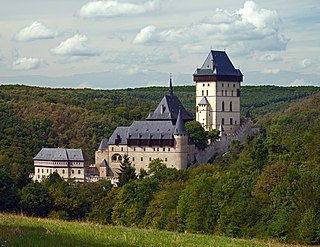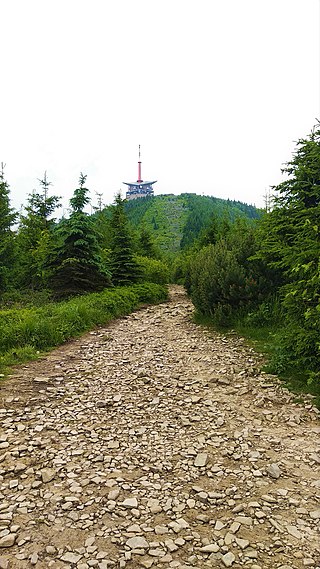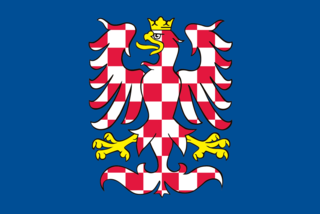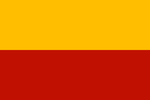
Bohemia is the westernmost and largest historical region of the Czech Republic. Bohemia can also refer to a wider area consisting of the historical Lands of the Bohemian Crown ruled by the Bohemian kings, including Moravia and Czech Silesia, in which case the smaller region is referred to as Bohemia proper as a means of distinction.

Moravia is a historical region in the east of the Czech Republic and one of three historical Czech lands, with Bohemia and Czech Silesia.

Demographic features of the population of the Czech Republic include population density, ethnicity, education level, health of the populace, economic status, and religious affiliations.

The Czechs, or the Czech people, are a West Slavic ethnic group and a nation native to the Czech Republic in Central Europe, who share a common ancestry, culture, history, and the Czech language.

Great Moravia, or simply Moravia, was the first major state that was predominantly West Slavic to emerge in the area of Central Europe, possibly including territories which are today part of the Czech Republic, Slovakia, Hungary, Austria, Germany, Poland, Romania, Croatia, Serbia, Ukraine and Slovenia. The formations preceding it in these territories were Samo's tribal union and the Pannonian Avar state.

The Czech lands or the Bohemian lands is a historical-geographical term which, in a historical context, denotes the three historical regions of Bohemia, Moravia, and Czech Silesia out of which Czechoslovakia, and later the Czech Republic, were formed. Together the three have formed the Czech part of Czechoslovakia since 1918, and the Czech Republic since 1 January 1993.

The Moravian-Silesian Region is one of the 14 administrative regions of the Czech Republic. Before May 2001, it was called the Ostrava Region. The region is located in the north-eastern part of its historical region of Moravia and in most of the Czech part of the historical region of Silesia. The region borders the Olomouc Region to the west and the Zlín Region to the south. It also borders two other countries – Poland to the north and Slovakia to the east.

The Principality of Nitra, also known as the Duchy of Nitra, was a West Slavic polity encompassing a group of settlements that developed in the 9th century around Nitra, in present-day Slovakia. Its history remains uncertain because of a lack of contemporary sources. The territory's status is subject to scholarly debate: some modern historians describe it as an independent polity that was annexed either around 833 or 870 by the Principality of Moravia, while others say that it was under the influence of the neighbouring West Slavs from Moravia from its inception.
The Moravian-Silesian Football League (MSFL) is one of the third level football leagues in the Czech Republic headquartered in Olomouc. The league comprises teams from the historic regions of Moravia and Silesia and partially also Bohemia.
The history of Moravia, one of the Czech lands, is diverse and characterized by many periods of foreign governance.

Moravané is a small non-parliamentary political party in Moravia in the Czech Republic.

The Czech–Slovak languages are a subgroup within the West Slavic languages comprising the Czech and Slovak languages.
Czechoslovaks is a designation that was originally designed to refer to a united panethnicity of ethnic Czechs and Slovaks. It has later adopted two distinct connotations, the first being the aforementioned supra-ethnic meaning, and the second as a general term for all citizens of the former Czechoslovakia regardless of ethnicity. Cultural and political advocates of Czechoslovak identity have historically ascribed the identity to be applicable to all people of Czech and Slovak heritage both in the country and in the diaspora.

Moravian dialects are the varieties of Czech spoken in Moravia, a historical region in the east of the Czech Republic. There are more forms of the Czech language used in Moravia than in the rest of the Czech Republic. The main four groups of dialects are the Bohemian-Moravian group, the Central Moravian group, the Eastern Moravian group and the Lach (Silesian) group. While the forms are generally viewed as regional variants of Czech, some Moravians claim them to be one separate Moravian language.

An official version of the flag of Moravia, unlike the provincial Moravian coat of arms, does not exist, because such a flag has never been granted to Moravia. However, there are several documented variants of Moravian flags used in the past. The first recorded version dates from the mid-13th century.

The Christianization of Bohemia refers to the spread of the Christian religion in the lands of medieval Bohemia. As in many other countries, Christianity was related to the establishment of a new state, and was implemented from the top down.

The Moravians were a West Slavic tribe in the Early Middle Ages. Although it is not known exactly when the Moravian tribe was founded, Czech historian Dušan Třeštík claimed that the tribe was formed between the turn of the 6th century to the 7th century, around the same time as the other Slavic tribes. In the 9th century Moravians settled mainly around the historic region of Moravia and Western Slovakia, but also in parts of Lower Austria and Upper Hungary.

The Bohemians or Bohemian Slavs, were an early Slavic tribe in Bohemia. Their land became recognized as the Duchy of Bohemia around 870.
The Merehani was a Slavic tribe mentioned by the Bavarian Geographer. They are often connected to the Moravians (Marhari), although some scholars believe that the tribe was separate.

The Moravian Land Movement is a political party in the Czech Republic that campaigns for the establishment of an autonomous region in Moravia and Czech Silesia. It was founded in 2018 as a breakaway from Moravané and claims to be the successor to the Movement for Autonomous Democracy–Party for Moravia and Silesia.
























